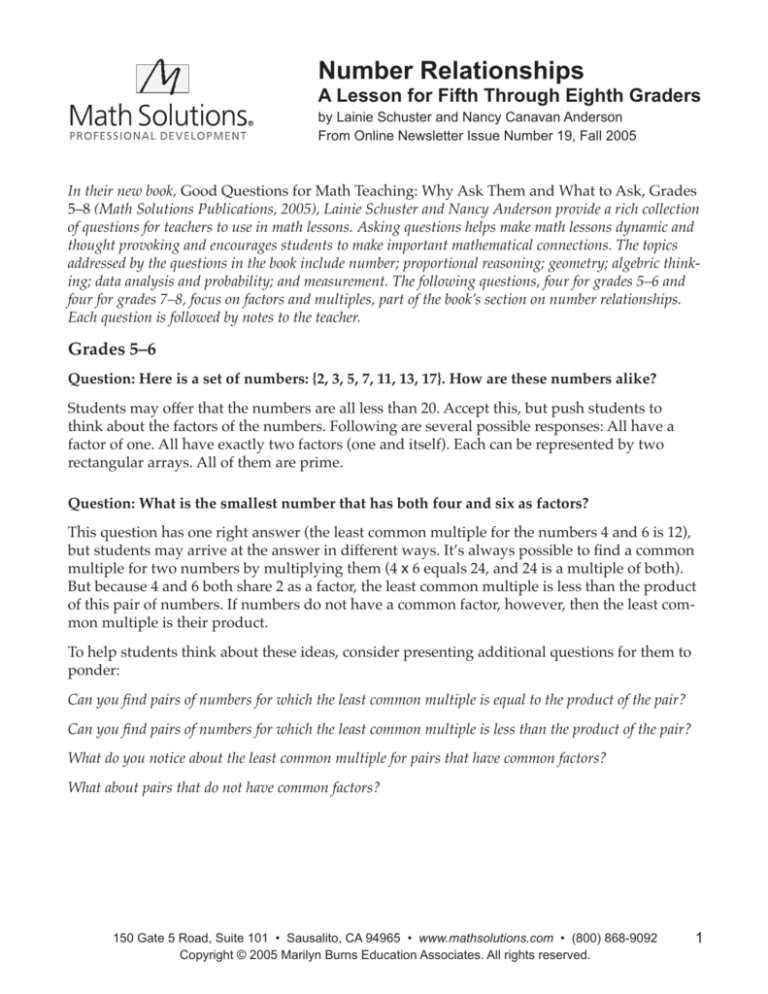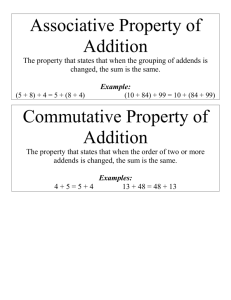
Number Relationships
A Lesson for Fifth Through Eighth Graders
by Lainie Schuster and Nancy Canavan Anderson
From Online Newsletter Issue Number 19, Fall 2005
In their new book, Good Questions for Math Teaching: Why Ask Them and What to Ask, Grades
5–8 (Math Solutions Publications, 2005), Lainie Schuster and Nancy Anderson provide a rich collection
of questions for teachers to use in math lessons. Asking questions helps make math lessons dynamic and
thought provoking and encourages students to make important mathematical connections. The topics
addressed by the questions in the book include number; proportional reasoning; geometry; algebric thinking; data analysis and probability; and measurement. The following questions, four for grades 5–6 and
four for grades 7–8, focus on factors and multiples, part of the book’s section on number relationships.
Each question is followed by notes to the teacher.
Grades 5–6
Question: Here is a set of numbers: {2, 3, 5, 7, 11, 13, 17}. How are these numbers alike?
Students may offer that the numbers are all less than 20. Accept this, but push students to
think about the factors of the numbers. Following are several possible responses: All have a
factor of one. All have exactly two factors (one and itself). Each can be represented by two
rectangular arrays. All of them are prime.
Question: What is the smallest number that has both four and six as factors?
This question has one right answer (the least common multiple for the numbers 4 and 6 is 12),
but students may arrive at the answer in different ways. It’s always possible to find a common
multiple for two numbers by multiplying them (4 x 6 equals 24, and 24 is a multiple of both).
But because 4 and 6 both share 2 as a factor, the least common multiple is less than the product
of this pair of numbers. If numbers do not have a common factor, however, then the least common multiple is their product.
To help students think about these ideas, consider presenting additional questions for them to
ponder:
Can you find pairs of numbers for which the least common multiple is equal to the product of the pair?
Can you find pairs of numbers for which the least common multiple is less than the product of the pair?
What do you notice about the least common multiple for pairs that have common factors?
What about pairs that do not have common factors?
150 Gate 5 Road, Suite 101 • Sausalito, CA 94965 • www.mathsolutions.com • (800) 868-9092
Copyright © 2005 Marilyn Burns Education Associates. All rights reserved.
1
Number Relationships, continued
Question: The weather is reported every 18 minutes on WFAC and every 12 minutes on
WTOR. Both stations broadcast the weather at 1:30. When is the next time the stations will
broadcast the weather at the same time?
This question provides students with a real-world context—telling time—for thinking about a
situation that involves numerical reasoning. The problem also provides a problem context for
thinking about multiples.
Question: Do you think that it makes sense to split a day into twenty-four hours? Would
another number have been a better choice? Why or why not?
This question, which doesn’t have a right answer, challenges students to think about a common, real-world application of number. You might also ask students if they think it makes
sense to have an amount other than 60 minutes in each hour, perhaps 100 minutes, for example. What effect would such a decision have on how time is displayed on watches and clocks?
Grades 7–8
Question: How is each number below different from each of the others?
81
81
36
14
List students’ reasons as they offer them, encouraging them to incorporate math vocabulary
into their reasons, such as divisor, factor, and divisible by. Discuss the meanings of the math
terms they use and the relationships among them. For example, suppose one student says,
“The number fourteen is the only number that doesn’t have nine as a factor,” and another
student says, “The number fourteen doesn’t belong because it’s the only number that’s not
divisible by nine.” Use these two statements to discuss the relationship between the terms
factor and divisible by.
This question can be asked for any set of four numbers. As an extension, ask students to
choose four numbers for others to consider. Then have them list all the ways the numbers differ from one another. Use their sets of numbers for subsequent class discussions. Finally, have
the student who suggested the numbers describe any differences that the class didn’t find.
Question: The students in Mr. Mila’s class want to know how old he is. Mr. Mila told them,
“My age can be written as the sum of consecutive odd numbers starting from one.” How old
might Mr. Mila be?
Adding consecutive odd numbers produces the sums of 4, 9, 16, 25, 36, 49, 64, 81, 100, and so
on. Of these, only some are reasonable predictions for Mr. Mila’s age—25, 36, 49, and 64. All
of these sums, however, are square numbers. Using different-colored square tiles or by coloring on squared paper, represent square numbers as squares to help students see that they can
be represented as the sum of odd numbers. Start with one tile or square colored in. Then, in a
different color, add three squares around it to create a 2-by-2 square, then five squares to create
a 3-by-3 square, and so on.
150 Gate 5 Road, Suite 101 • Sausalito, CA 94965 • www.mathsolutions.com • (800) 868-9092
Copyright © 2005 Marilyn Burns Education Associates. All rights reserved.
2
Number Relationships, continued
Talk with students about extending this pattern.
Question: Four students in Mrs. Burge’s math class were comparing locker numbers. They
made the following observations:
Our four locker numbers are relatively prime to one another.
Exactly two of our locker numbers are prime.
What might the students’ locker numbers be?
Discuss the terms prime and relatively prime and the distinction between them. Then have
students work on answering the question. Post students’ answers and, for each, have the class
verify whether the numbers meet the given criteria. Finally, ask students to write their own
definitions of prime and relatively prime. Have them share their ideas, first in pairs and then
with the whole class.
Question: For homework, Kim Lee was practicing adding integers. He looked at one problem and said, “I know the sum will be negative.” Based on Kim Lee’s statement, what do
you know about the problem?
This question aims to help students generalize about the relationship between the sign of the
sum and the numbers in an integer addition problem. Students may need to make a list of
integer addition problems whose sums are negative and look for commonalities among them
in order to answer this question.
150 Gate 5 Road, Suite 101 • Sausalito, CA 94965 • www.mathsolutions.com • (800) 868-9092
Copyright © 2005 Marilyn Burns Education Associates. All rights reserved.
3









